Updated 18/7/2025
Barnes Wallis and the Dancing Bomb
Born on September 26, 1887, Barnes Neville Wallis, died 30 October 1979, was an English engineer and inventor of the “Dancing Bomb”.
Operation Chastise – The Dambuster raid
Operation Chastise was a very dangerous mission. The mission demanded very much of the pilots’ ability and the strategy and technique used had never been seen before.
The targets were a number of dams in the Ruhr region, the industrial heart of Germany. The Möhne dam took care of the water supply and also served to generate power for the industry. The 2nd and 3rd goal were the Eder and Sorpe dams.
The plan to destroy the dams had been around since 1937, but the problem was that conventional weapons were not strong enough to destroy the dams. It was not until 1942 that British technician Barnes Wallis developed a bomb that could “dance” over the water. Normal torpedos did not work because the dams were equipped with nets to catch the torpedoes.
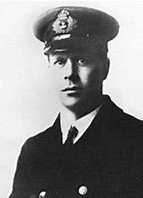
He was inspired by the behavior of stones he threw across the pond in his garden. The stones, if thrown at a certain angle, “danced” over the water and then sink to the bottom. Wallis thought the same technique could be used with a specially developed bomb to blow up the dams. The bomb (actually a mine) had the shape of an oil drum, similar to a depth bomb that was used to sink a submarine (codename Upkeep) and had to be thrown off from a height of 18 meters and at a speed of 390 km. The heavy bomb was 4100 kg. The intention was that the bomb would “dance” over the water until just before the dam and then would sink and explode.
Arthur (Bomber) Harris didn’t like the plan. He described Wallis’s plan as “the most idiotic proposition he had ever come across,” but was overruled by Air Chief Marshall Charles Portal.
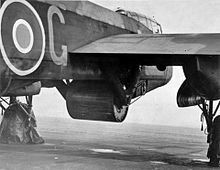
19 Lancaster bombers (type B Mark III special) were converted to store and shed the Upkeep bombs. Each bomb was hung in special bearings and around the bomb a tight belt was stretched that was connected to an engine, which was supposed to ensure that the bomb would get the right backspin just before ejecting, at 500 rpm. The bomb was partly hanging outside the plane and the bomb doors had been removed. What was still needed were 19 very experienced crews, who should succeed after a training period performing the action. A special squadron was created. Squadron 617 was led by 24-year-old Guy Gibson, with crews from Commonwealth, America and the RAF itself. A month of practice was held at the no longer in use Nant-y-Gro dam in Wales in low flying and navigating in the dark. Gibson was the only one who knew the ultimate goal of the operation.
The attack on the dams finally took place on May 16, 1943 and was divided into three waves of attack:
Formation 1, 9 aircraft, attack leader Guy Gibson, targets the Möhne and Eder dam
Formation 2, 5 aircraft, attack leader Joe McCarthy, target the Sorpe dam
Formation 3, 5 aircraft, attack leader Cyril Anderson, reserve group, deployable where necessary, if possible targets Lister, Ennepe and Diemel dams
The routes were chosen in such a way that as much air defenses as possible could be avoided and that low could be flown, about 30 meters to avoid the radar.
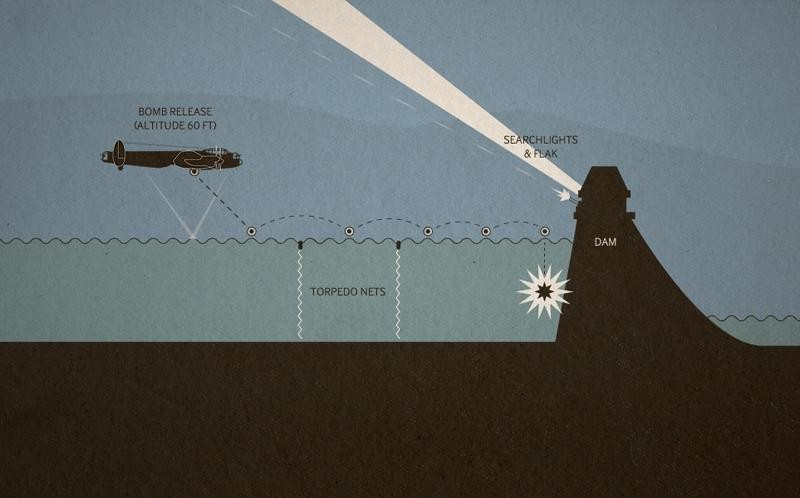
The first attack wave:
Gibson, reached the Möhne dam, did not hit the dam and was able to return to base
Hopgood, reached the Möhne dam despite a number of hits along the way, did not hit the dam but did hit the power station and was shot down at the dam (2 crew members survived the crash)
Martin, reached the Möhne dam, did not hit the dam and could return to the base
Young, reached the Möhne dam, caused a minor damage and was shot down on the return flight off the Dutch coast near Castricum
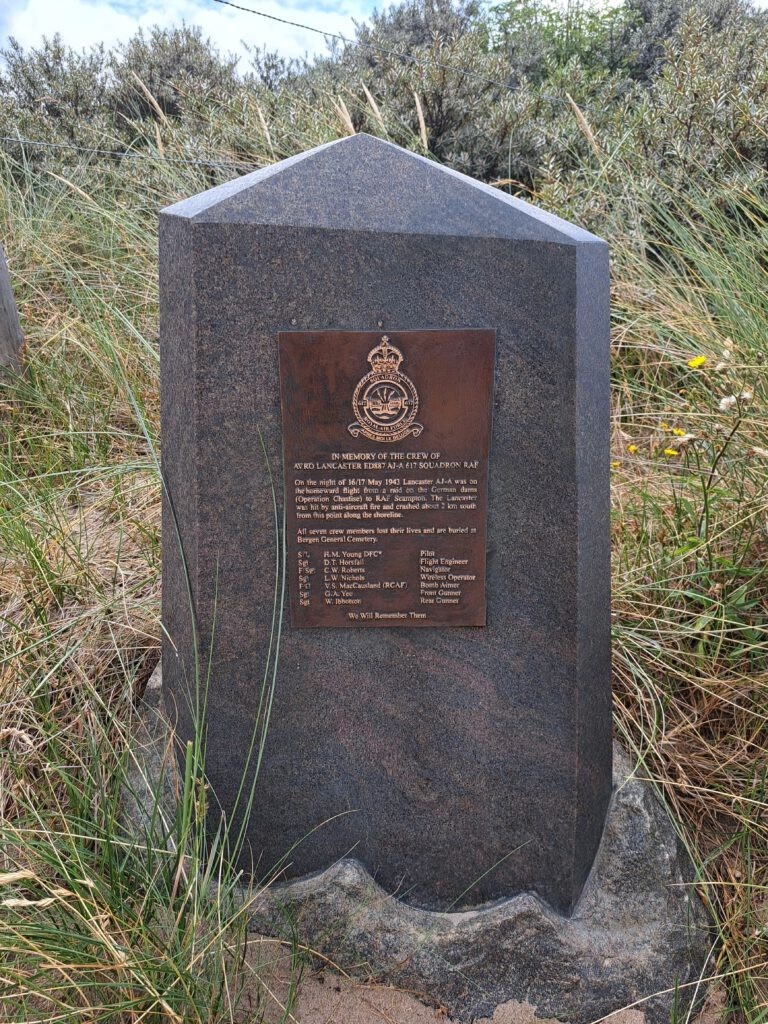
Text on the monument:
“ In memory of the crew of Avro Lancaster ED887 AJ-A – 617 squadron RAF
On the night of 16/17 may 1943 Lancaster AJ-A was on the homeward flight from a raid on the German dams (Operation Chastise) to RAF Scampton. The Lancaster was hit by anti-aircraft fire and crashed about 2 km south from this point along the shoreline. All seven crew members lost their lives and are burried at Bergen General Cemetery.
H.M. Young, pilot, D.T. Horsfall, flight engineer, C.W. Roberts, navigator, L.W. Nichols, wireless operator, U.S. MacCausland (RCAF), bomb aimer, G.A. Yeo, front gunner, W. Ibbotson, rear gunner
Maltby, reached the Möhne dam, caused a major fracture and could return to base
Shannon, reached the Eder dam, caused no damage and could return to base
Maudslay, reached the Eder dam, caused no damage, but the bomb damaged the aircraft. The plane was shot down during the return flight at Netterden
Knight, reached the Eder dam, caused a major breakup and could return to base
Astell, did not reach the dams, hit high-voltage power lines on the outward flight and crashed at Marbeck
The second wave of attack:
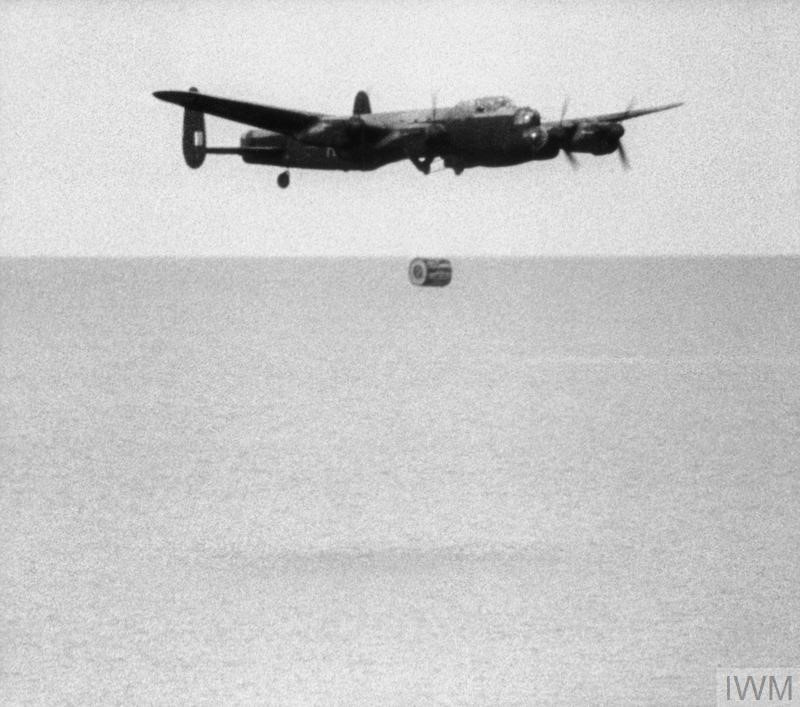
McCarthy, reached the Sorpe dam, also hit the dam, but caused no damage. Could return to base
Barlow, did not reach the dam, hit high-voltage power lines and crashed on the outward flight at Haldern
Byers, did not reach the dam and was shot on the outward flight off the Dutch coast near Texel, Wadden Sea
Rice, hit the water from the IJsselmeer on the outward flight, lost the bomb and returned to the base
Munro, was hit by defense guns off the Dutch coast and returned to base
The third wave of attack:
Anderson, could not find the target and returned to base
Brown, reached the Sorpe dam, hit the dam, but caused no damage. Returned to base
Townsend, reached the Sorpe dam, hit the dam, but caused no damage. Returned to base
Burpee, did not reach the dam and was shot down over the Netherlands on the outward flight at Gilze-Rijen
Ottley, did not reach the dam and was shot down above Germany on the route to the Listerdam (1 crew member survived the crash)
Victims crew members:
11 aircraft have landed back on base, 8 have crashed.
53 of the 133 crew members were killed. 3 crew members were captured.
Deaths in Germany:
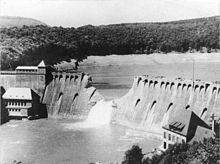
The two dam breakthroughs (Möhne and Eder) caused a huge tidal wave, with between 1300 and 1600 victims (of which 750 are prisoners of war) and a huge damage to the villages that were victimized by the man-made tsunami. More than 1000 residential houses, 125 factories and more than 30 farms were damaged. 7000 workers from various places in Germany were removed to repair the damage. A request to bomb the dams again during the recovery phase was rejected by Bomber Command, which ultimately caused the mission little damage.
The influence of the attack on industrial production was limited, but the attack caused a significant resurgence of the morale of the British.
Barnes Wallis and the Tallboy
The Tallboy was a heavy aircraft bomb used at the end of the second world war. The bomb weighed more than 5000 kg and could be thrown off by a special version of the Lancaster at an altitude of 6000 meters. The bomb was developed with the aim of penetrating deep into the surface before exploding. The bomb consisted of a thick mantle of hardened steel. The damage the bomb caused was mainly caused by the seismic wave that was produced.
The bombs were used to destroy the Nazis’ V1, V2 and V3 installations and also for an attack on the Nazi battleship the Tirpitz on November 12, 1944. The Tirpitz sank in the Tromsofjord. Also in IJmuiden two Schnellboot bunker were bombarded with Tallboys. One became unusable and the other was never phased out.
There were never many Tallboys made. The production costs were high due to material costs and precise production with a lot of manual work.
Barnes Wallis and the Grand Slam Earthquake
Later, a modified version of the Tallboy was designed by Barnes Wallis, the Grand Slam Earthquake bomb. This bomb was a larger version of the Tallboy and weighed 10,000 kg. 32 Lancaster B MK1 bombers with more powerful engines and a stronger landing gear and a minimum of other things to save weight were developed to be able to release the bomb. A total of 42 Grand Slams were dropped in Germany.
Percy Hobart and Hobart’s funnies

Percy Cleghorn Stanley Hobart was a British soldier during World War II. He was born on June 14, 1885 and died on February 19, 1957. Percy was born in India. He studied at Clifton College and graduated from the Royal Military Academy in Woolwich in 1904. He was added to the Corps of Royal Engineers and fought during the First World War in France and Mesopotamia. In 1934 he was appointed a sergeant of the 1st Armoured Brigade in Great Britain and promoted to major general in 1937. In 1940, Percy was forced to retire. In 1941 he returned and became commander of the 11th Armoured Division, later of the 79th Armoured Division.

He became responsible for the specialized armoured vehicles, the Hobart’s Funnies. These were mainly used during the Normandy landings and the battles that followed. Especially the Sherman Crab (Sherman converted into a mine clearer, equipped with a flail), has ensured that on the landing beaches Gold, Juno and Sword on June 6, 1944, during D-Day, the infantry could eventually make its way through the obstacles and minefields on the beaches. Important other inventions included the Churchill Crocodile – a flamethrower on the chassis of a Churchill tank. The fire cannon was mounted on the site of the machine gun. An AVRE (Armoured Vehicle Royal Engineers) – a Churchill tank converted into a military engineer tank. An ARC (Armoured Ramp Carrier) – a Churchill tank with folding bridge parts on both sides. A DD tank – A Sherman or Valentine with a canvas screen so that the tank was given enough buoyancy to sail using two screws. A BARV (Beach Armoured Recovery Vehicle) – a Sherman converted into a beach stow away tank and a Centauer Bulldozer – a Cromwell tank converted into a bulldozer.
William Kilbourn and the Sherman Firefly

The Sherman tank was the most commonly used tank by the Allies in WWII. The tank took its name from American General William T. Sherman and was originally an American design. A total of 49,000 of them were produced. The tank was equipped with a 75mm cannon and that was in practice not able to withstand the German Tiger and Pantzer tank. Moreover, due to its high design, the tank was an easy target for anti-tank guns and enemy tanks. The back was (as with the German Tiger) the weakest spot. The armor was very light, which allowed fuel and ammunition to catch fire quickly. Hence the nickname Tommy Cooker, because many tank crews were killed by burning.
In order to improve the Sherman in such a way that the tank was able to handle the German Tigers and Pantzers, an English invention was used and the Sherman Firefly was born. It was designed by William George Kennings Kilbourn, born in 1892 in Leicester and in the service of Vickers. Kilbourn adjusted the Sherman’s gun dome between August and November 1943 and replaced the normal cannon with a 17-pound anti-tank cannon. That took quite a few changes. The original hydropneumatic braking mechanism was replaced by an entirely new shorter and more powerful system. However, due to the lower length, the cannon became out of balance, about half a ton. For this he designed an extra booty to better clamp the barrel forward more forward and made at the back of the sleeve catcher of metal instead of canvas. This tank version of the cannon he called the Mark IV, a later improved version was the Mark VII.
On November 11, he had the drawings ready for a possible mass production. On November 28, the first prototype of the cannon was ready and the second on November 30. They were tried at the shooting ranges at Woolwich and Shoeburyness. To prevent the heavy cannon from unevenly burdening the tower, that tower was further balanced by a small armored rectangular protrusion at the back, in which the radios were accommodated, which by the larger gun should have already moved. A square hole was cut in the back wall of the tower in connection. Nevertheless, the rotation speed decreased, mainly because of the higher absolute weight; an unexpected advantage was that this improved the fine adjustment when aiming. The disadvantage was that the gunner had to operate the radio, which during the fight made coordination with other tanks impossible. Because the larger cannon also closed the flight path of the charger, it was given an extra towering hatch on the left. This also proved to be useful for loading new ammunition into the tank. The ammunition stock was limited from 97 to 78 pieces given the larger length of the grenades; five of which were installed in the tower itself for direct use. Another eighteen were directly tilted out of a compartment in the floor; forty, however, were located horizontally in two replenishment boxes of twenty under the tower floor and were only accessible if the tower had been turned into a special position. The last fifteen were placed next to the driver in a compartment at the place where the machine gunman was normally sitting; hence the number of crew members had been reduced from five to four.
At the end of 1943, the pressure from the field troops to employ heavier armed tanks was increasing. In December 1943, the Royal Ordnance Factory was ordered to convert 2100 Shermans. Where the name Firefly comes from is not entirely clear. She showed up in March 1944 but was never the official designation.
The Nazis’ retaliatory weapons, the Vergeltungswaffen
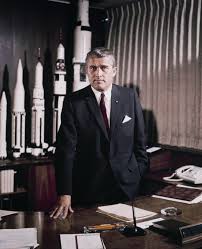
The hobby of Wernher von Braun
At the end of the Second World War, the demise of the Third Reich approached with big steps. Joseph Goebbels introduced a number of Vergeltungswaffen, to revive the German initiative.
The V1
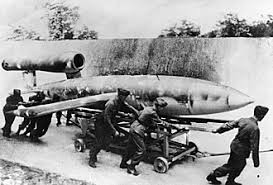
The V1 was actually an unmanned aircraft, powered by a pulsating jet engine on ordinary kerosene, with a length of 8 meters. If the target was set (up to 240 kilometers, later 420 kilometers) and reached, the V1 dived down and exploded on the ground. The V1 was launched from a catapult installation. The first launch took place on June 13, 1944, a week after D-Day. The goal was London.
A pulsating jet engine is a simple jet engine with valves instead of turbines. Rehearsingly, a gas mixture in the engine is brought to explosion several times per second. It is a motor with a very small number of moving parts. The engine was designed in 1939 by Paul Schmidt and a variant was built during the Second World War by the Argus Motorenfabriek for use in the V1. The V1 itself had aircraft wings and a horizontal stabiliser and was built by Fieseler. The combustion frequency was around 45 pulses per second and caused a specific sound by which one could recognize the V1. At the time the target was reached, the V1 dived down and the engine turned off. That was the sign that the V1 would hit pretty quickly.
A V1 had 830 kilograms of Amatol stored in the nose.
From June 1944, about 8000 V1s were launched to London and Antwerp. About 2400 V1s reached their destination. According to other sources, the numbers were higher. The launches took place in France and in the west and later also the east of the Netherlands.
The nickname of the V1 was buzz-bomb or doodlebug.
The V2

After a preliminary phase that started in 1930, Wernher von Braun promised in September 1943 that the A-4 prototype (Agregat 4) development was almost finished. It was the first man-made object to reach space. The Nazis considered missiles to be an alternative to long-range artillery. In 1936 the production of the V2s on the island of Peenemünde started. Here could be tested with launches above the Baltic Sea where the result was visible from the coast. The most successful A-4 prototype was 14 metres long, weighed 13 tonnes, including 9 tonnes of fuel and an explosive head of 750 kg of amatol. The rocket was powered by a mixture of ethanol and liquid oxygen. On October 3, 1942, the first launch took place, the rocket flew more than 200 kilometers, achieved a speed of mach5 and an altitude of 85 kilometers. The A-4 prototype was later renamed V2. Despite the fact that the V2 was not always very reliable, Hitler was sufficiently impressed that he approved the production of 250 V2s per month.
The four basic technologies were a large liquid fuel rocket engine, supersonic aerodynamics, steering using gyroscopes and rudders to control the direction.
Initially, the V2s were produced in Peenemünde, but the Royal Air Force had tracked down the activities and on 17 August 1943 the research centre was attacked. With more than 700 deaths on the ground and provisionally postponed production, it was decided to continue production underground. The new location was Mittelbau-Dora, near Nordhausen in Thuringen. Thousands of workers from the nearby concentration camp had to work on the V2 program under appalling conditions. 20,000 of the 60,000 workers did not survive.
On 8 September, the first V2 was launched towards London. From mobile launchers in France and the Netherlands, around 3200 V2s were fired to London and Antwerp. There was nothing that could be done if they descended towards the earth. The V2s were very effective. 2700 Persons were killed in London and 2200 in Antwerp. The impact on the cinema Rex in Antwerp already cost 567 lives.
The V2 campaign did not last long. Due to the Allied advance, the launchers were soon taken and the rocket attacks stopped.
Each V2 cost the Nazis 100,000 Reichsmarken, the total investment estimated at two billion dollars, the equivalent of 20,000 Tiger tanks, or 800 submarines.
The V2 was the inspiration for the later American missiles developed by Wernher von Braun for America.
The V3
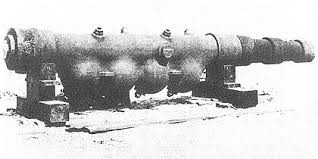
The V3 was a high-pressure cannon with a range of 90 kilometers, intended to be able to bomb London. The V3 had a 130-meter-long barrel, with short side branches with an explosive charge. These side charges were electrically detonated as soon as the projectile passed the side branch. This always resulted in a huge acceleration. The projectiles that had to be fired were three metres long and had a diameter of eleven centimeters. The speed that was reached was around 5400 km per hour. A complex with five of these cannons was built in Mimoyecques in France, but never became operational. A shortened variant of 58 meters in length was used during the Ardennes offensive to bomb Luxembourg.
The V4

The V4 was a four-stage rocket developed in 1943, eleven metres long and could be fired at a speed of around 5000 kilometers per hour. The rocket was fired from a mobile platform, a so-called Meillerwagen and weighed 1560 kg. The rocket was able to reach targets more than 220 kilometres away. The head contained an explosive load of “only” 30 kg. In the Netherlands, at the end of December 1944, four of these missiles were fired from the current Zandenbos near Nunspeet with the aim of bombing the ports of Antwerp. 15 Missiles were fired from this location, in total 200. Due to an erroneously specified fire angle, the rockets shot past Antwerp and ended up near Gend. The damage was minor compared to the V1 and V2.
Source:
History.net
IsGeschiedenis.nl
Demounted – Gerard Groeneveld
Wikipedia